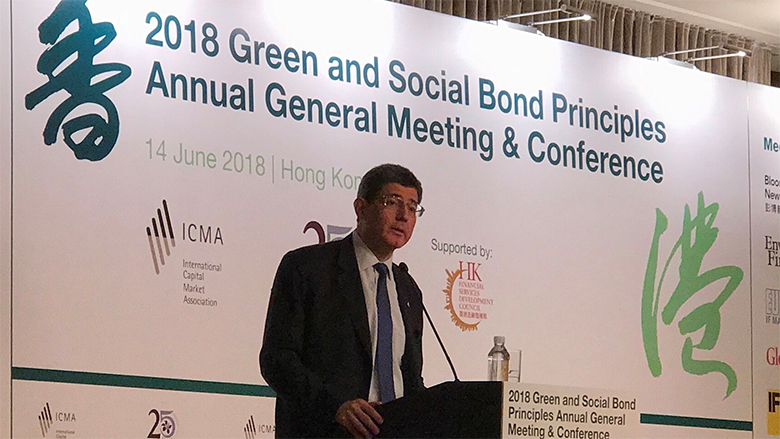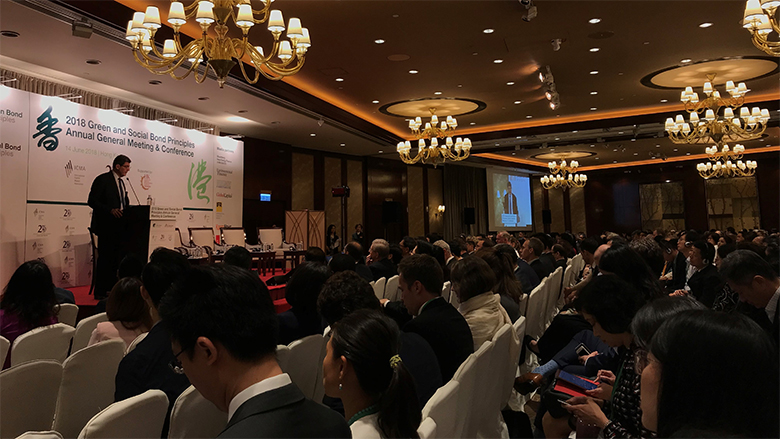Good afternoon, ladies and gentlemen. I am very pleased to be here with you today. I congratulate the ICMA and the Hong Kong Monetary Authority for co-hosting this very important event.
The sheer growth of the market for green bonds, and now social bonds, attests to their success as a crucial gateway to mobilizing funding that can help address climate change and achieve the Sustainable Development Goals by 2030.
Our commitment to the green bond market remains strong, while we are pleased to see that financial, corporate, sovereign and sub-sovereign issuances are now much bigger than those from MDBs. The World Bank issued the first green bond in November 2008, opening the plain vanilla market after EIB’s first structured note in 2007. That was 10 years ago, and we never stopped! Just two months ago, we issued our first-ever green bond denominated in Hong Kong dollars, which at HK$1 billion was also the first benchmark-sized green bond to be issued by a supranational issuer in Hong Kong. This represented the 19th currency in which we have issued. Meanwhile our instruments are also changing, with new vehicles such as the $2 billion IFC-Amundi Green Bond fund. This is the world’s largest fund focusing on emerging markets, and it will help local banks issue green bonds to lend to green projects.
The economics of green bonds, and the ways we keep the market’s integrity, are more important than ever. We want green bonds to affect issuer behavior in pursuing an overall, long-term concrete business strategy aimed at low-carbon and climate-resilient growth. We understand that this happens project-by-project and bond-by-bond, even for not fully green entities. This is a major difference in the way to look at ESG consistency for bonds and stocks. The latter, being a residual claim, reflect the issuer’s overall activities—fully green or not. In the case of the bonds, we are mostly looking at the margin.

Of course, we prefer when ESG and the SDGs are native to all the issuer’s activities. But we understand that green bonds derive their value from funding the incremental transformation towards greater sustainability. This promise, however, can only happen if there is clarity with respect to the use of proceeds, the process supporting the choice of projects, and the expected impact. How detailed the map of areas eligible to green bond funding ought to be is one of the key questions being discussed here, and I hope our answer to it—how comprehensive or stringent taxonomies are to be—will reflect a balance between the goals of market integrity, growth and diversity, subject to very strong transparency, disclosure and adequate tracking of resources.
Another question is whether green bonds command a price premium. Even though many investors are increasingly driven to asset classes that observe sustainability principles, most cannot afford to pay an upfront premium, due to return maximization requirements, including by supervisors. Of course, green bonds can tap new markets, and there is some evidence that the initial spreads of green bonds may sometimes be below plain vanilla bond spreads. But more analysis is needed to see whether there is any genuine, non-government driven, premium due to lower risk. And the question needs to be put into a broader context: for instance, how to compare the risk and potential premium of bonds financing a solar park to those financing a fossil fuel generation plant, when we factor in carbon prices, other sustainability issues, and potential regulatory changes in the future?
These questions will become central, as the public sector tries to address perceived market failures and the positive externality provided by green bonds. We are familiar with the proposals by the European Commission’s High-Level Expert Group on Sustainable Finance to include green awareness as the fiduciary responsibility of asset managers. And with those from the Chinese authorities on reducing the cost of central bank liquidity for banks that hold green bond portfolios. These government interventions are bound to affect the pricing of green bonds and the incentives to issuers. They also raise issues of incentive alignment, and regulatory overreaching and fragmentation, among other unintended consequences.
With respect to incentive alignment, the best answer is probably reinforcing disclosure, making internal processes, management of resources, and ultimate impact verifiable. These concepts, rather than meticulous regulation, remain central to green bonds, and they carry over to the new market of Social Bonds. Indeed, we are happy that they are cornerstones of the new Social Bond Principles. But reality is that as governments move, the market architecture, standards, and the certification process run the risk of becoming a heavy and more national affair rather than a shared, collective responsibility. Coordination, led by ICMA and MDBs, is key to promoting convergence of standards and a healthy global market, without excessive regulation, but effectively protecting public resources. [I believe the action of ICMA and meetings like the ones being held around the region, including the World Bank conference together with Chinese authorities on June 26, are effective ways to promote convergence and a healthy market.] public resources.)
These are reason I also believe that focusing on impact is crucial. ICMA’s leadership has helped generate consensus on the degree of disclosure we have today, benefitting from the experience of MDBs and input from investors. It has worked very well for green bonds, and I am pleased to see that these common efforts have resulted in additional guidance for impact reporting on social bonds, which were published in time for this conference.
As I start to wrap up these remarks, let me note that we have to keep our ambitions high and act accordingly. Funding trillions of US dollars per year to reach the SDGs raises the bar on “themed bonds.” This is because it requires not only the financing of specific projects associated with the most common labels, but also financially supporting governments and other entities, as they implement transformative policies. The importance of this support to EMDEs will only increase, as WB research points to a certain stagnation in commodity prices in the next decade, even if oil prices remain volatile.
We use the proceeds from our entire funding portfolio to partner with countries to respond to the tremendous pressures they face, as they scramble to develop policies and mobilize funds for climate-friendly infrastructure and different ways to help the private sector create jobs, especially for the youth, who have higher aspirations than ever. We are happy that IBRD sustainable bonds and IDA impact bonds are meeting with great interest from a wide range of sustainability-minded investors. We will strive to continue to enhance the transparency and coverage of the reporting on the expected—and actual— impact of our activities, as IBRD is also to adopt an <integrated reporting> approach.
Let me conclude. Investors’ and issuers’ commitment to sustainable practices is what is driving the success of green, social and sustainability bonds, by raising awareness and sharpening our focus on sustainable outcomes. Count on us to further foster all labels, and to ensure that all our activities meet high ESG and SDG standards and goals. Looking at the impact of a marginal project is very important, but looking at, and getting certification on, a wholly sustainable balance sheet can be even more desirable, and helps us to issue fully SDG bonds.
I look forward to the discussions today, which will help identify important areas of work ahead of us.
Thank you all.



